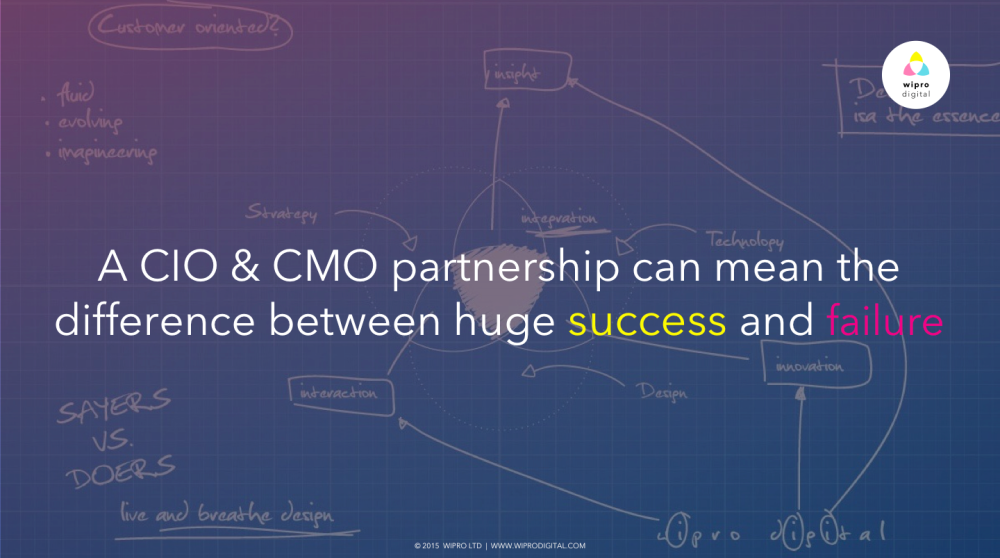CIO & CMO Partnership: Focus on Marketing Technology Governance
10 Jun 2015

by Gene De Libero
Head of Strategy, Wipro Digital
@GeneDeLibero
CIO & CMO Partnership: Focus on Marketing Technology Governance
At the Gartner Digital Marketing Conference 2015, there were a fair number of marketing technology (MarTech) vendors pitching their products and services. That wasn't unexpected, given the position of many analysts, including Gartner, which had predicted that sometime this decade, the Chief Marketing Officer (CMO) would spend more on IT than the Chief Information Officer (CIO).
Borrowing a phrase from the writer William Gibson, the future is already here, and the power shift from CIO to CMO is gaining momentum. The MarTech space is jam-packed with vendors eager to deal directly with CMOs who are more than willing to keep their CIO colleagues out of the loop. As with all great relationships, the two individuals, or departments in this case (IT and Marketing), have to agree to work towards a common goal. But that will require making their differences work for one another, and ultimately, for the company. Easier said than done, and with an ever-growing catalog of MarTech vendors courting CMOs, it’s not getting any less difficult.
In December 2014, VentureBeat called out 52 funding, IPO, and acquisition events in the MarTech space during the year’s last three months alone. Using v3.0 of Scott Brinker’s popular “marketing technology landscape supergraphic,” VentureBeat counts some 947 companies in six classes across 43 categories. Based on consistent funding and M&A activity in the MarTech space, and my recent conversations with attendees at the Gartner shindig, this list is far from complete and subject to constant change.
Marketing is becoming more digital and data-driven, and the untethered consumer is more demanding than ever. The message to CIOs not ready, willing, or able to come to grips with this inevitable power shift to CMO, which in some cases includes pushing a CIO down the corporate ladder to directly report to a CMO, is very clear: find a way to play nice in the sandbox or get your resume ready.
One area where I believe the CIO can stake a claim and create real value as a partner to the CMO, is the area of governance. As CIOs are well aware, the power of marketing technology comes with great responsibilities, including proper care and feeding of the people, processes, platforms, and technologies that make this new world of marketing go. (Can you say “data security?”) Most importantly, as Brinker says in this blog post, there’s a marked difference between governance and management.
Since the dawn of the IT department, the CIO has been responsible for the governance of IT security, regulatory compliance, and other checks-and-balances in the selection, implementation, use, and management of technology. Marketing, and other business units across the enterprise, have worked with CIOs and their teams to make governance part of the day-to-day adoption of technologies within their own particular worlds.
But as anyone who’s ever had the pleasure of receiving a rejected IT request knows, that governance can slow the business down, and in general, IT departments are known for saying “no” more often than “yes”. This sometimes-acrimonious relationship between IT and the business is known to spawn assorted flavors of shadow IT, where business units procure and implement IT systems and solutions outside the chain of IT command (and normal governance roadmap).
This is where CIOs can make a huge difference as partners to CMOs. CIOs who work closely with CMOs to gain a deeper understanding of the marketing technology landscape can lend their expertise to help choose, implement, and support MarTech in a way that meets or exceeds IT and other governance requirements. This can create a meaningful and productive partnership between CIOs and CMOs, which can greatly empower CMOs and their teams to innovate with confidence.
A tighter CIO/CMO partnership can mean the difference between huge success and failure. What better place to forge a bond than in the area of governance? It’s an area the CMO would prefer to avoid like the plague and one that the CIO cannot avoid.
What’s your take? I’d love to hear from you.
Originally posted via Wipro Digital





1.png)

Please login to comment.
Comments